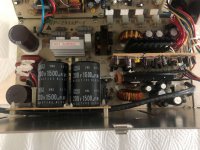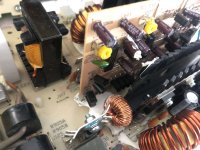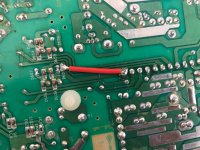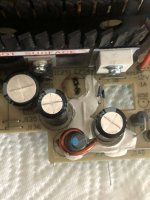BadGoldEagle
Well-known member
Hi all,
I had just about the time to install 8.1 on this machine before its power supply died. I had received the new capacitors from Arrows a couple of days prior, so I set out replacing them all. The thing is, it's a really difficult PSU to work on. It's got two main PCBs, and a daughterboard that's soldered onto one of those main PCBs so I had to manually desolder it before changing the caps (I didn't take the desoldering gun with me when I moved. I still have it, but it's 400 miles away from where I am). There is approx. 10+ pins on this daughterboard and I ended up lifting one pad. I tested it for continuity, it was still good but I didn't feel particularly comfortable putting it back in this condition. I have dupont wires, but they are way too thin for this application (I use it for small trace repairs, but this one is about 3x as thick as your standard trace...). So I did nothing and put it back together.
Before I tackled this repair, the relay in the PSU would click, but that was about it. No fan or LED.
When I powered it on after the repair, it came back to life, and worked great for about an hour, before the PSU started resetting itself every 2 seconds or so. The power LED is now off, the fan works.
I've tried powering it back up after letting it cool for two hours but the clicking's still here.
I haven't taken it apart again since then because it has some monstrous caps, and I already shocked myself once the day before yesterday. I'll leave it unpowered for two days, just to be safe.
So my question to you guys is the following: In order to repair a trace that's about half a centimetre (or .2 inch) thick, what sort of gauge wire should I get?
The pins on the daughterboard this trace/pad connects to is relatively small, about the half the thickness of a standard 3.5mm headphone jack, or about the same size as the pins that connect to the PCB of a Nubus card. It's small but not flimsy.
I hadn't finished recapping the power supply entirely before putting it back in the Mac. I tried replacing the big caps that are of the snap in type, but couldn't get them to fit as they should. So I kinda stopped and forgot about the 3 or 4 'standard' ones left. But the fact it worked great for an hour and suddenly stopped leads me to think something died because of heat. I'd say that trace is toast. I tried touching up the pad that got lifted before the initial smoke test and only made it worse. It was completely off and hanging about 1mm off. But continuity was still good.
Looking forward to your comments on this... I guess I could always perform the ATX mod but I don't particularly feel inclined to do it.
Thanks!
I had just about the time to install 8.1 on this machine before its power supply died. I had received the new capacitors from Arrows a couple of days prior, so I set out replacing them all. The thing is, it's a really difficult PSU to work on. It's got two main PCBs, and a daughterboard that's soldered onto one of those main PCBs so I had to manually desolder it before changing the caps (I didn't take the desoldering gun with me when I moved. I still have it, but it's 400 miles away from where I am). There is approx. 10+ pins on this daughterboard and I ended up lifting one pad. I tested it for continuity, it was still good but I didn't feel particularly comfortable putting it back in this condition. I have dupont wires, but they are way too thin for this application (I use it for small trace repairs, but this one is about 3x as thick as your standard trace...). So I did nothing and put it back together.
Before I tackled this repair, the relay in the PSU would click, but that was about it. No fan or LED.
When I powered it on after the repair, it came back to life, and worked great for about an hour, before the PSU started resetting itself every 2 seconds or so. The power LED is now off, the fan works.
I've tried powering it back up after letting it cool for two hours but the clicking's still here.
I haven't taken it apart again since then because it has some monstrous caps, and I already shocked myself once the day before yesterday. I'll leave it unpowered for two days, just to be safe.
So my question to you guys is the following: In order to repair a trace that's about half a centimetre (or .2 inch) thick, what sort of gauge wire should I get?
The pins on the daughterboard this trace/pad connects to is relatively small, about the half the thickness of a standard 3.5mm headphone jack, or about the same size as the pins that connect to the PCB of a Nubus card. It's small but not flimsy.
I hadn't finished recapping the power supply entirely before putting it back in the Mac. I tried replacing the big caps that are of the snap in type, but couldn't get them to fit as they should. So I kinda stopped and forgot about the 3 or 4 'standard' ones left. But the fact it worked great for an hour and suddenly stopped leads me to think something died because of heat. I'd say that trace is toast. I tried touching up the pad that got lifted before the initial smoke test and only made it worse. It was completely off and hanging about 1mm off. But continuity was still good.
Looking forward to your comments on this... I guess I could always perform the ATX mod but I don't particularly feel inclined to do it.
Thanks!







